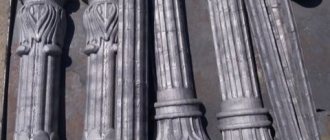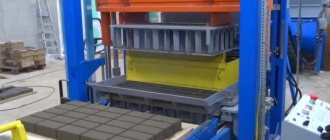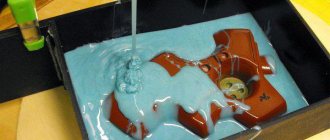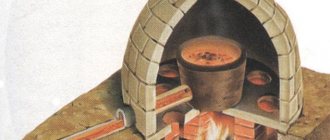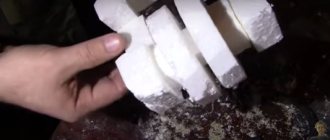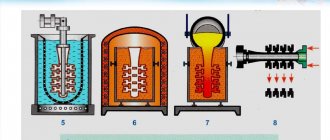Beton-House.com
Website about concrete: construction, characteristics, design. We combine the experience of professionals and private craftsmen in one place
Concrete casting technology is suitable for making small figurines as well as massive objects such as flower bowls, shells, etc.
Concrete is a building material known to mankind for a very long time. So long ago that today there are heated debates about the natural origin of the building material of the Egyptian pyramids, since recent studies show the presence inside the “megaliths” of traces of sheep wool and other foreign inclusions, which by definition cannot be in real stone.
Unfortunately, this has nothing to do with the topic of our article, although it is very interesting - our goal is to find out how the production of molds for casting concrete takes place, as well as the process of pouring concrete objects.
Cast concrete
Cast concrete was developed and introduced into the construction industry at the end of the 20th century.
Cast concrete
Its main purpose is finishing of horizontal surfaces. With its use, concrete casting no longer requires labor-intensive vibration compaction, and high-quality surfaces became accessible to a basic craftsman without complex and bulky tools.
When are they needed?
Molds for concrete products are indispensable in the manufacture of construction and decorative products by casting. The smaller and more refined the parts, the higher the quality requirements for the matrices. With their help, various construction samples and products for concrete decorations are produced:
Adaptations are necessary for those who make paving slabs.
- blocks for construction;
- fencing;
- paving slabs;
- reinforced concrete slabs;
- architectural accessories;
- blocks or rings for fireplaces;
- drainage trays;
- monolithic or hollow products.
Advantages and disadvantages of poured concrete
The main advantage of cast concrete is its plasticity. This makes it easier to pour and there is no need to resort to vibration compaction, as is required when pouring conventional concrete.
Basic characteristics of plasticity
The composition of cast concrete also includes additives that retain moisture in the material. This increases the time available for surface adjustment and increases the spreadability of the composition.
Cast concrete is also resistant to moisture penetration, can remain in contact with the ground for a long time and can withstand contact with water for a certain time. Polymer additives make the material insensitive to temperature changes.
Plasticity of cast concrete
The main and, perhaps, the only disadvantage of cast concrete is its high cost due to the high price of polymer additives, which make up up to one twentieth of the total volume.
What are the tracks for?
Garden paths perform two important functions:
- Improve landscape design, give the garden a well-groomed appearance;
- After precipitation, it will be possible to cross the site along the paths, get to the gazebo, etc. The paths are easy to clear of snow. So improved trafficability, zoning, emphasizing the boundaries of flower beds - these are the functional tasks of the paths.
Method of casting concrete for the manufacture of concrete products
Casting concrete products into matrices in single copies or small runs does not require complex equipment. In this case, you can get by with manual mixing and manual compaction of the solution.
If you plan to cast concrete into molds in medium quantities, it is better to get a concrete mixer and a vibrating compactor.
Making concrete castings at home is a simple process. However, the master should pay attention to a number of subtleties.
If it is necessary to cast large products, such as curbs, posts or piles, it is better to make the formwork from wood or OSB. When casting products with a side measuring more than half a meter, additional stiffening elements will be required so that the formwork does not burst during pouring. The formwork should be made collapsible and should be thoroughly wetted before pouring the solution. This will make it easy to remove the formwork after the casting has hardened, preventing the concrete from sticking to the form. A mold made of OSB, plywood or metal is lubricated with machine oil for the same purpose.
If wood is not available, then, as a last resort, the casting matrix can be dug into the ground. You need to pour sand into the dug hole, moisten it well and pour the solution. Of course, the dimensional accuracy and surface quality in the case of casting into the ground will be more than modest.
Types of injection molds
Ready-made matrices are made of plastic, wood, metal, polyurethane, fiberglass. Among the wide variety of concrete molds for casting, you can find models designed for :
- production of paving slabs (paving stones, garden paths, massive slabs);
- creating curbs and gutters;
- casting of facing and facade tiles, having the appearance of crushed natural stone;
- production of fences, pillars, one-sided and double-sided fences, inserts;
- creating elements of landscape architecture (vases, street trash cans, benches, flowerpots, fountains, canopies, balusters, lamp posts, sculptures, balustrades, etc.).
Many homeowners who want to save on buying forms for pouring concrete make them themselves from scrap materials. Wooden and metal molds are made in such a way that the parts can be separated and the finished product can be removed. A concrete figure can be removed from silicone matrices without much effort.
How to make cement mortar correctly?
The ability to independently prepare cement mortar at home will be useful to anyone who plans to engage in construction or repair work. An adhesive mass that hardens over time is necessary for laying bricks, for creating decorative stone compositions, and even for filling a hole in the wall.
To build garden paths, you need a regular solution, which you can prepare yourself. However, its functional qualities largely depend on the preparation of the material and proportions, so we will consider in detail how to fill molds for garden paths so that it serves for many years.
What needs to be prepared?
Perhaps someone in their country property will have a mobile concrete mixer (in this case, the process of preparing the mass will be more efficient and faster), but it is unlikely that this useful unit can be found in the average garden farm, so we will assemble an arsenal from what is constantly available at hand.
It is very important to choose the right container that is suitable both in size and in ease of working with it. Ideally, the volume of the tank should correspond to the portion of solution that you want to prepare in one go. A container that is too small will force you to repeat the procedure - and this will double the time spent on work. In a large bowl it is inconvenient to stir the ingredients and create a homogeneous mass. Also important are the qualities of the tank, such as the stability and strength of the walls.
For small volumes of cement (if you make tiles slowly, for example, on weekends), a small container made of durable plastic with low sides is suitable
If you happen to have an old cast-iron bathtub at your dacha, which is usually used to store rainwater, it can be an excellent temporary option for diluting cement mortar, or other large dishes that meet the listed requirements.
In addition to the container, you need a tool to stir the mass until smooth. It is a mistake to use a shovel or a wooden block - the solution will clump into lumps, which will affect the poor quality of the tiles.
The best equipment is a construction mixer or, as it is also called, a hand mixer; if you don’t have one, you can use a drill with a special attachment
Try to put everything in one place so that during the cooking process you don’t have to leave and delay the process.
Component Selection
Standard, widely used cement mortar requires 3 parts: cement, sand and water. It would seem that everything is simple - I mixed everything together and got an excellent material for pouring into molds. However, there are several important points, failure to comply with which will immediately affect the quality of the tiles. For example, sand. You can find several types of sand that differ in particle size, weight, and composition.
We will use ordinary quarry or river sand, which has such characteristics as purity (for this it must be washed), uniformity, and absence of impurities.
Cement - a dry mixture in paper bags - must be crumbly, fresh, and not expired. If you have a couple of bags stored in your utility room from a construction site 10 years ago, it’s better to say goodbye to them, because you won’t get a good mortar from such cement.
Here are some tips from construction professionals to help you make a great solution:
- If you notice small lumps in the dry mixture, it is better to sift the powder using a special sieve (for working with stone, 10mm x 10mm cells are sufficient, but for plastering work you will need a sieve with 5mm x 5mm cells).
- The best type of cement for street work is grade 300 or 400.
- Correctly determine the proportions of all three components. For paths, the traditional ratio of 1:3 is ideal, where 1 part cement accounts for 3 parts sand. Bulk materials can be measured in buckets or other suitable containers.
- To give a certain shade or change certain characteristics (viscosity, strength), modern components are added to the solution, for example, plasticizers or colored granules.
When preparing the solution, make sure that it does not become greasy, that is, containing a lot of binding component. The greasy mass is plastic, convenient for application, but forms a composition that quickly dries out and cracks over time - this is not suitable for garden paths. If there is a lack of a binding element, we will get thin cement that will harden for too long and also have unsuitable characteristics.
We need normal cement, which, after hardening, has excellent strength and wear resistance, and for this it is necessary to maintain proportions.
A bag of cement weighing 25 kg costs from 180 to 250 rubles. The price depends on the manufacturer, brand and quality of the dry mixture
Add water “by eye”, a little at first, then add in small portions. The result should be a mass resembling thick sour cream in viscosity.
Recent Entries
Lilac perennials that are beautiful, compact and do not crowd out other plants Why when buying seedlings you should not take the sellers’ word for it and how to determine the age of the plant using 3 signs Tomato seedlings have turned purple or whitish: why the color has changed and how to save the plants
Preparation of cement mortar
Keep in mind that the finished solution can be used for several hours, then it will be unsuitable for pouring, so first prepare the table, molds, stencils - everything that is necessary for the production of paving slabs.
Pour cement and sand into the container in thin layers - you should get at least 5-6 layers. This is necessary for high-quality, uniform mixing of the components. Stop when the total height of the “pie” reaches 25-30 cm. Then take a shovel and try to carefully but vigorously mix the components of the mixture: the more actively you move the shovel, the better the quality of the future solution.
The homogeneity of dry cement mortar can be determined by eye. If you have doubts about the purity of the mass, pass it through a sieve again.
Water can be added only after you are sure that the dry mixture is completely ready, or rather, that it is homogeneous. It is better to take a small container and add in small portions so as not to overdo it and make the solution too liquid. Pour in the water slowly, stirring the mixture lightly.
A mistake that novice builders make is experimenting with the temperature of the poured liquid. Some believe that hot water will speed up the dilution process, and they specially heat it, while others pour in ice-cold liquid. Both are incorrect and can negatively affect the quality of the solution. The water should be the same temperature as the surrounding atmosphere - in our case we are, of course, talking about the warm season.
The ready-to-use mixture for pouring molds should be slightly thinner than cement mortar for bricklaying
Another nuance concerns the moisture content of the sand. Sand stored directly on the site is often used. Obviously, it could get wet when it rained. If you are using wet, heavier sand, add even less liquid. Is the solution ready yet? Start pouring. Depending on the thickness and viscosity of the composition, you have 1-3 hours to pour the solution into molds.
